
Decoy Airfields


Nazeing Common 'KQ' site.
One
of
wartimes
carefully
kept
secrets
was
the
building
of
dummy
or
decoy
airfields.
Nazeing
Common,
just
to
the
south
of
present
day
Harlow,
was
such a site.
Designed to be a decoy for nearby North Weald airfield, this site was for day and night use, hence the designation 'KQ'.
The
idea
for
dummy
structures
or
installations
was
designed
to
attract
bombs
away
from
the
real
airfield,
It
stemmed
from
an
idea
by
Colonel
John
Turner, a Civil Engineer who became head of 'Works & Buildings' with the Air Ministry.
He
was
instrumental
in
conceiving
these
decoy
airfield
sites,
of
which
over
two
hundred
and
thirty
were
built.
He
was
himself
a
pilot
and
also
understood
the
infrastructure
and
design
of
military
airfields.
With
his
HQ
in
the
Shepperton
Film
studios,
his
department
had
the
knowledge
of
deceptive construction, the big film company's were masters at creating an illusion from canvas and wood.
Dummy
Hawker
Hurricane
aircraft
made
from
These
materials,
among
other
things,
were
produced
by
a
company
called
Greens
Engineering,
and
were
deemed
very
effective
when
in
place.
On
these
sites
these
dummy
aircraft
were
moved
around
to
simulate
day
to
day
movement
on
the
'airfield'
to German reconnaisance aircraft and also their night bombers.
Regular
RAF
airmen
were
used
to
man
these
'airfields'.
They
were
also
protected
by
anti-aircraft
guns
and
had
the
same
lighting
system
in
appearance
as
a
normal
airfield.
By
the
use
of
some
very
clever
lighting
the
men
could
simulate
moving
aircraft
and
create
flarepaths,
the
illusion
to
German
bomber
crews
was
very
effective.
and
for
all
intents
and
purposes,
from
a
height,
these
dummy
airfields
looked
like
the
real
thing
and
succesfully attracted bombs away from the real airfield.
Command
and
control
bunkers
were
built
away
from
the
layout
of
the
'airfield'
so
as
to
give
the
crews
some
protection.
These
buildings
housed
generators
for
powering
the
lighting
and
had
an
ops
room
where
the
the
lights
were
operated
from,
and
where
contact
could
be
maintained
by
telephone
to
the
controlling
station
ie:
North
Weald
itself.
The
other
bunker
at
Nazeing
was
used
for
shelter
and
a
general
area
for
sleeping
and
cooking.
There
were
two
incidents
involving
aircraft
trying
to
attempt
a
landing
on
the
decoy
airfield
at
Nazeing
common.
A
Vickers
Wellington
of
9
squadron
from
Honington
Norfolk
was
returning
from
an
operational
flight
and
made
a
less
than
perfect
landing.
It
was
dismantled
by
an
RAF
recovery
crew
from North Weald and sent for repair. A Percival Proctor training aircraft also suffered the same fate.
The
land
on
the
site
is
as
it
appears
today,
very
hilly,
and
not
at
all
what
you
expect
from
an
'airfield'.
The
lighting
was
mounted
on
wooden
poles
of
varying lengths, so as to keep the proportion and angles right in it's appearance from the air.
These
sites
were
in
operation
from
June
1940,
but
it
is
thought
the
Germans
had
detected
Nazeing
as
a
decoy
site
by
the
end
of
December.
The
site
probably
closed
by
the
end
of
July
1941
as
land
was
needed
for
increased
agriculture.
The
decoy
was
originally
built
on
common
grazing
land,
and
this was put to the plough in August 1941.
Today,
as
you
drive
from
Bumbles
Green
towards
Harlow,
it
is
possible
to
see
one
of
the
bunkers
protruding
from
the
field.
The
main
part
of
the
decoy
airfield was further to the east on farmland.
A
small
page
from
a
diary
kept
by
a
pupil
at
the
nearby
Bumbles
Green
school
reveals
the
amount
of
ordnance
dropped
by
German
bombers
in
the
vicinity of the Decoy airfield at Nazeing common. This page was found during renovations at the old school that is now being converted to a house.
All that can be seen from aerial images are the two underground control bunkers. These were build some distance from the actual decoy airfield to
protect the working crew from enemy bombs that were dropped on or near the site.

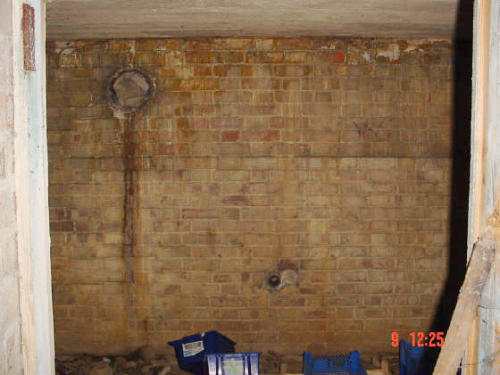
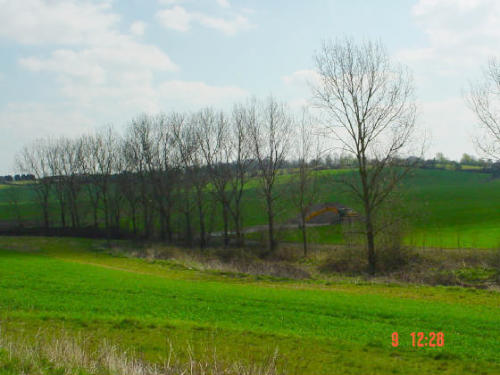




Wartime Airfields
rjkdesign
Wartime Airfields
rjkdesign


Wartime Airfields
Wartime Airfields


Decoy Airfields
Nazeing Common 'KQ' site.
One
of
wartimes
carefully
kept
secrets
was
the
building
of
dummy
or
decoy
airfields.
Nazeing
Common,
just
to
the
south
of
present
day
Harlow, was such a site.
Designed
to
be
a
decoy
for
nearby
North
Weald
airfield,
this
site
was
for
day and night use, hence the designation 'KQ'.
The
idea
for
dummy
structures
or
installations
was
designed
to
attract
bombs
away
from
the
real
airfield,
It
stemmed
from
an
idea
by
Colonel
John
Turner,
a
Civil
Engineer
who
became
head
of
'Works
&
Buildings'
with the Air Ministry.
He
was
instrumental
in
conceiving
these
decoy
airfield
sites,
of
which
over
two
hundred
and
thirty
were
built.
He
was
himself
a
pilot
and
also
understood
the
infrastructure
and
design
of
military
airfields.
With
his
HQ
in
the
Shepperton
Film
studios,
his
department
had
the
knowledge
of
deceptive
construction,
the
big
film
company's
were
masters
at
creating an illusion from canvas and wood.
Dummy
Hawker
Hurricane
aircraft
made
from
These
materials,
among
other
things,
were
produced
by
a
company
called
Greens
Engineering,
and
were
deemed
very
effective
when
in
place.
On
these
sites
these
dummy
aircraft
were
moved
around
to
simulate
day
to
day
movement
on
the
'airfield'
to
German
reconnaisance
aircraft
and
also
their
night
bombers.
Regular
RAF
airmen
were
used
to
man
these
'airfields'.
They
were
also
protected
by
anti-aircraft
guns
and
had
the
same
lighting
system
in
appearance
as
a
normal
airfield.
By
the
use
of
some
very
clever
lighting
the
men
could
simulate
moving
aircraft
and
create
flarepaths,
the
illusion
to
German
bomber
crews
was
very
effective.
and
for
all
intents
and
purposes,
from
a
height,
these
dummy
airfields
looked
like
the
real
thing and succesfully attracted bombs away from the real airfield.
Command
and
control
bunkers
were
built
away
from
the
layout
of
the
'airfield'
so
as
to
give
the
crews
some
protection.
These
buildings
housed
generators
for
powering
the
lighting
and
had
an
ops
room
where
the
the
lights
were
operated
from,
and
where
contact
could
be
maintained
by
telephone
to
the
controlling
station
ie:
North
Weald
itself.
The
other
bunker
at
Nazeing
was
used
for
shelter
and
a
general
area
for sleeping and cooking.
There
were
two
incidents
involving
aircraft
trying
to
attempt
a
landing
on
the
decoy
airfield
at
Nazeing
common.
A
Vickers
Wellington
of
9
squadron
from
Honington
Norfolk
was
returning
from
an
operational
flight
and
made
a
less
than
perfect
landing.
It
was
dismantled
by
an
RAF
recovery
crew
from
North
Weald
and
sent
for
repair.
A
Percival
Proctor training aircraft also suffered the same fate.
The
land
on
the
site
is
as
it
appears
today,
very
hilly,
and
not
at
all
what
you
expect
from
an
'airfield'.
The
lighting
was
mounted
on
wooden
poles
of
varying
lengths,
so
as
to
keep
the
proportion
and
angles
right
in it's appearance from the air.
These
sites
were
in
operation
from
June
1940,
but
it
is
thought
the
Germans
had
detected
Nazeing
as
a
decoy
site
by
the
end
of
December.
The
site
probably
closed
by
the
end
of
July
1941
as
land
was
needed
for
increased
agriculture.
The
decoy
was
originally
built
on
common grazing land, and this was put to the plough in August 1941.
Today,
as
you
drive
from
Bumbles
Green
towards
Harlow,
it
is
possible
to
see
one
of
the
bunkers
protruding
from
the
field.
The
main
part
of
the
decoy airfield was further to the east on farmland.
A
small
page
from
a
diary
kept
by
a
pupil
at
the
nearby
Bumbles
Green
school
reveals
the
amount
of
ordnance
dropped
by
German
bombers
in
the
vicinity
of
the
Decoy
airfield
at
Nazeing
common.
This
page
was
found
during
renovations
at
the
old
school
that
is
now
being
converted
to a house.
All that can be seen from aerial images are the two underground control
bunkers. These were build some distance from the actual decoy airfield
to protect the working crew from enemy bombs that were dropped on or
near the site.
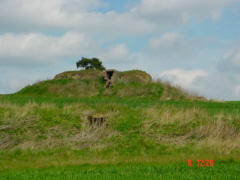
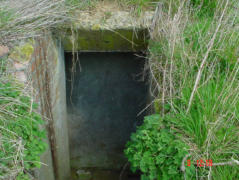
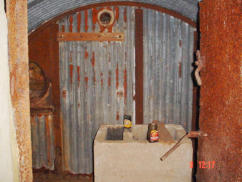
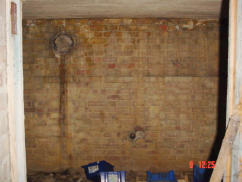
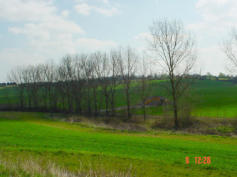
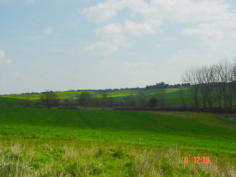
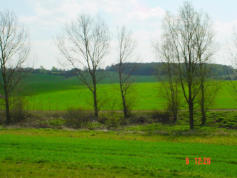
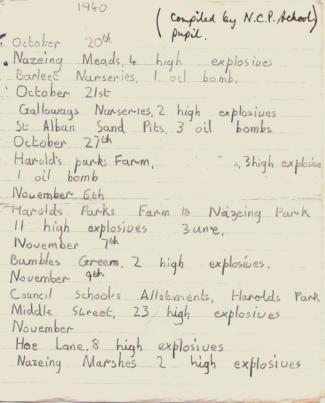
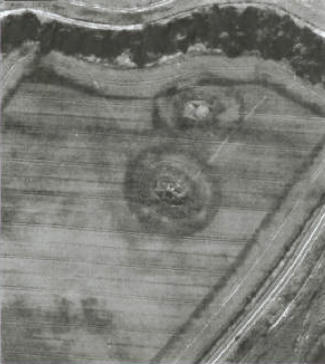

rjkdesign













